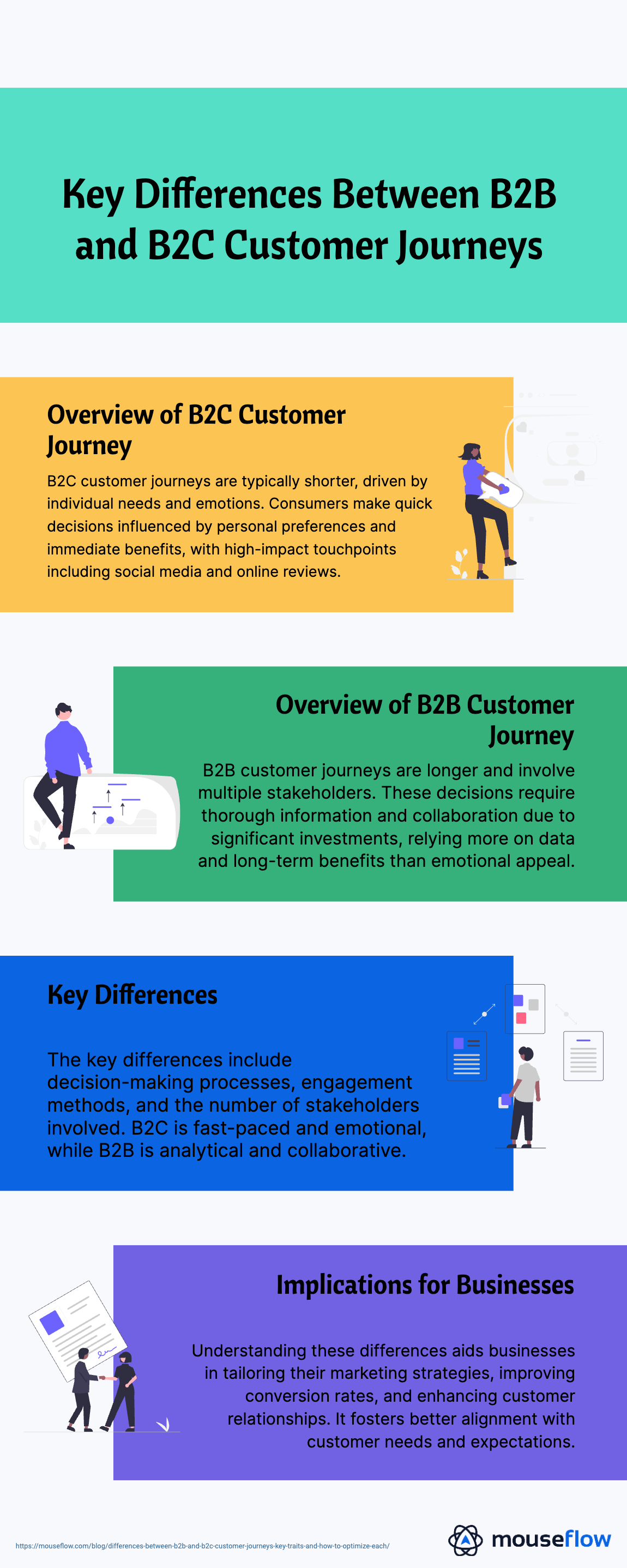Understanding the differences between B2C and B2B customer journeys is essential for businesses looking to optimize their marketing, sales, and customer experience strategies. Both types of customer journeys involve distinct decision-making processes, engagement methods, touchpoints and customer behavior. By tailoring approaches to each journey type, businesses can meet customer needs more effectively, build stronger relationships, and improve conversion rates.
Overview of B2C Customer Journey
In B2C (Business-to-Consumer) customer journeys, interactions are generally shorter and more direct, driven by individual needs and emotions. Since B2C purchases often involve smaller transaction amounts and fewer stakeholders, the decision-making process tends to be quicker and influenced by personal preferences, immediate benefits, and emotional responses.
Characteristics of B2C Customer Journey
- Emotional Decision-Making: Consumers in a B2C journey are often influenced by emotions, social proof, and brand identity. Their decisions may be driven by desires, lifestyle alignment, or immediate needs.
- Shorter Decision Cycles: Due to the typically lower financial commitment, B2C customers move through the journey more quickly than B2B customers. They might browse, compare, and make a purchase within the same session.
- High-Impact Touchpoints: Key touchpoints often include website interactions, social media, reviews, and product pages. For eCommerce, these touchpoints include product discovery, cart, and checkout.
Common Stages in a B2C Customer Journey
- Awareness: The customer becomes aware of a product or service, often through ads, social media, or recommendations.
- Consideration: They explore the brand’s offerings, looking at products, features, and reviews to determine if it meets their needs.
- Decision: A purchase is made. Factors influencing this decision include pricing, availability, and ease of checkout.
- Retention: Post-purchase engagement focuses on satisfaction, support, and loyalty-building efforts, such as newsletters or loyalty programs.
Overview of B2B Customer Journeys
In B2B (Business-to-Business) customer journeys, interactions are typically longer and involve multiple stakeholders. Because B2B purchases often represent significant investments, the decision-making process is more complex and requires thorough information, trust-building, and collaboration among decision-makers.
Characteristics of B2B Customer Journeys
- Logical Decision-Making: B2B customers make purchasing decisions based on ROI, product fit, reliability, and long-term benefits. Emotional appeal is less influential than data, case studies, and evidence of effectiveness.
- Longer Decision Cycles: Due to the complexity of B2B solutions and the financial implications, B2B journeys take longer. This process often includes consultations, demos, and detailed product evaluations.
- Multiple Stakeholders: The B2B journey typically involves several decision-makers or influencers (e.g., finance, operations, management), each with unique priorities.
Common Stages in a B2B Customer Journey
- Awareness: A business realizes a need and starts researching potential solutions, often prompted by industry trends, pain points, or company growth.
- Consideration: The business evaluates different vendors or solutions, consulting various team members, looking at product demos, and requesting proposals.
- Decision: After thorough vetting, the decision-making team finalizes a solution based on factors like pricing, scalability, and vendor reliability.
- Retention: Post-purchase, the focus shifts to ensuring successful implementation, ongoing support, and long-term ROI. Retention efforts often include training, customer success initiatives, and regular account check-ins.Get The Guide to Customer Retention for SaaS
Other Journey Types
While B2C and B2B are the two primary journey types, additional journey types also play significant roles in enhancing customer satisfaction and retention. Here’s a look at two other critical journey types:
-
Customer Support Journeys
Customer Support Journeys focus on users seeking support or issue resolution and are crucial in both B2C and B2B settings. These journeys directly impact customer satisfaction, as users expect timely and effective support when they encounter issues. The ease and quality of support interactions influence overall brand perception, with a seamless support experience often leading to greater loyalty and advocacy.
Common Stages in a Customer Support Journey:
Issue Awareness: The customer identifies a problem or need for assistance.
Seeking Support: They reach out through various channels such as chat, phone, email, or self-service options.
Resolution: The issue is addressed, either through self-service resources or with help from a support agent.
Follow-Up: Depending on the resolution, the business may follow up with a survey or additional support to ensure the issue is fully resolved and the customer is satisfied.
-
Customer Retention and Customer Loyalty Journeys
Retention and Loyalty Journeys focus on keeping customers engaged after the initial purchase. These journeys aim to foster loyalty, increase lifetime value, and turn customers into brand advocates through ongoing support, loyalty programs, or personalized recommendations. Retention and loyalty are essential for both B2C and B2B businesses, as retaining existing customers is generally more cost-effective than acquiring new ones.
Common Stages in a Retention and Loyalty Journey:
Post-Purchase Engagement: Initial follow-ups post-purchase ensure the customer is satisfied with the product or service.
Loyalty Programs or Benefits: Brands offer loyalty points, discounts, or perks to incentivize repeat purchases or continued engagement.
Personalized Recommendations: Using purchase history and browsing behavior, brands provide tailored product recommendations, reinforcing customer engagement.
Advocacy: Satisfied customers become advocates, sharing positive experiences and promoting the brand to others, which drives organic growth.
Key Differences Between B2C and B2B Customer Journeys
Understanding the differences between B2C and B2B customer journeys is essential for businesses that cater to one or both types of customers. Here are some of the main distinctions:

-
Decision-Making Process
B2C: Primarily influenced by emotions and immediate needs; decisions are often made quickly with minimal deliberation.
B2B: Decisions are typically logical and require approval from multiple stakeholders. The process is data-driven and relies on evidence, such as case studies, product demos, and ROI projections.
-
Engagement and Relationship-Building
B2C: Relationships are built through direct interactions like personalized marketing, loyalty programs, and responsive customer support.
B2B: Relationships are built over time through ongoing support, training, and account management. Trust and reliability are critical, often fostered through one-on-one engagement and long-term partnerships.
-
Complexity and Transaction Size
B2C: Purchases are generally lower in cost and less complex. A simple, frictionless purchase experience is crucial.
B2B: Purchases are higher in cost and complexity, with many B2B transactions involving customized solutions, negotiated contracts, and longer onboarding.
-
Role of Content
B2C: Content that resonates emotionally and captures attention quickly, such as videos, reviews, and social proof, is impactful.
B2B: Detailed content, including white papers, case studies, and product comparisons, is essential for educating stakeholders and building trust throughout a lengthy decision process.
Examples of B2C eCommerce vs. B2B SaaS Customer Journeys
- B2C eCommerce Brand: An eCommerce retailer aims to engage B2C customers through product discovery, efficient checkout, and quick shipping options. By using personalized email recommendations, social media ads, and an optimized checkout experience, they successfully shorten the journey from awareness to purchase, catering to immediate consumer needs.
- SaaS B2B Company: A SaaS provider targets a B2B client with a focus on lead nurturing, consultations, and custom solutions. The journey starts with a webinar or white paper download, followed by product demos and meetings with sales. The SaaS company’s success lies in providing consistent follow-up, customized solutions, and a dedicated customer success team, which drives client engagement and long-term retention.
Implications for Businesses
To optimize the customer journey for B2C and B2B audiences, businesses must tailor their approach based on the unique characteristics of each journey type. Here are a few actionable strategies:
-
For B2C Journeys:
- Simplify the Purchase Process: Remove friction in the buying process, ensuring a fast and intuitive checkout.
- Use Emotional Appeal: Appeal to consumers’ emotions through storytelling, social proof, and lifestyle-focused content.
- Engage with Personalization: Use personalized marketing techniques like email recommendations and retargeting to keep customers engaged.
-
For B2B Journeys:
- Build Trust with In-Depth Content: Provide case studies, product demos, and ROI calculators to help stakeholders make informed decisions.
- Foster Strong Relationships: Prioritize relationship-building through regular follow-ups, customer success initiatives, and one-on-one interactions.
- Offer Ongoing Support and Training: Ensure customers receive the support they need post-purchase, building trust and loyalty through a proactive customer success team.
Conclusion
Understanding the differences between B2C and B2B customer journeys, along with other essential journey types like Customer Support Journeys and Retention and Loyalty Journeys, is crucial for tailoring strategies that meet the unique needs of each audience. By optimizing each journey type based on these distinctions, businesses can create personalized, effective experiences that increase engagement, drive conversions, and build lasting relationships.


